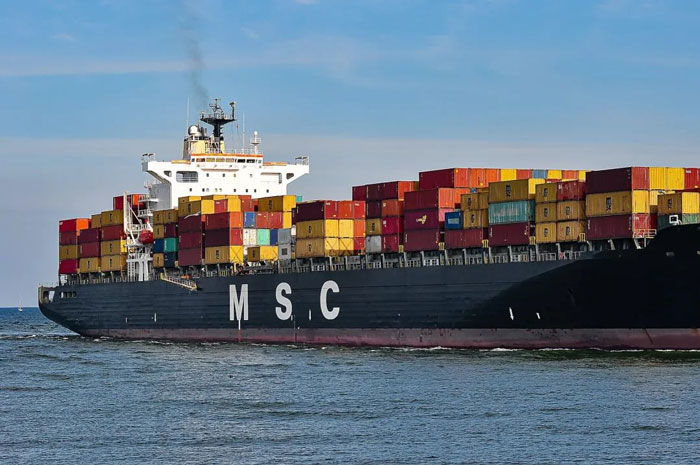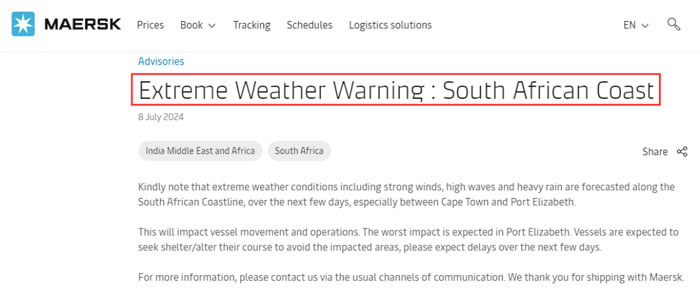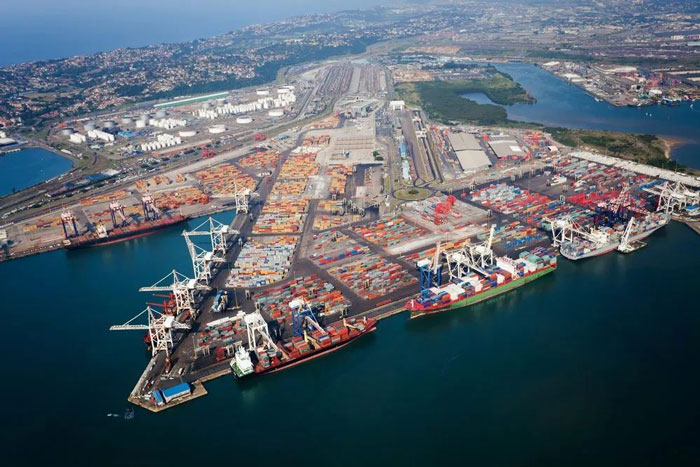

Cargo ships sailing around the Cape of Good Hope are in trouble off South Africa
Bad weather in South Africa has delayed the clean-up plan
Recently, the South African Maritime Authority (SAMSA) received a report from an unknown vessel that "an oily substance and oil sheen were found on the water surface" in the Algoa Bay area near Port Elizabeth (Gqeberha). After investigation, it was initially determined that the oil came from MSC Apollo. Later reports said they had also found stains on the hull of the MSC Apollo.
SAMSA said it had planned to conduct an oil monitoring operation on Sunday, but high winds in the area in the morning limited the operation, and a helicopter inspection operation in the afternoon did not detect oil at sea level.
SAMSA then contacted the ship's agent and insurance company and developed a model of the oil spill trajectory. However, bad weather again hampered the next move.
Meanwhile, the MSC Apollo is also scheduled to have its hull cleaned during berthing to prevent oil from being transferred to the water. But also due to the local bad weather, rough seas made the cleaning work impossible.
According to local media in South Africa, efforts are currently underway to determine the cause and extent of the oil leak on the MSC Apollo.
The bad weather put passing ships in trouble one after another
The headache is not just for SAMSA, but for all the ships that need to stop and pass through. Severe weather this winter has wreaked havoc on shipping in the region.
On 28 August, the Liberian-flagged MSC Antonia lost 46 containers and damaged another 305 containers off the coast of South Africa's Indian Ocean Corridor.
On 16 August, the Maltese flagged container ship Dafibelem encountered bad weather near Richards Bay, resulting in a severe stacking collapse on board and the loss of 99 containers.
On July 11, the very large container ship CMA CGM Benjamin Franklin, also flying the Maltese flag and also owned by CMA CGM, lost as many as 44 containers in the same part of South Africa's Indian Ocean region while passing through South Africa on its way from Asia to Europe.
The Panamanian-flagged cargo ship Ultra Galaxy ran aground in a remote area of South Africa's west coast in early July, breaking into four sections after being "battered" by a storm and reporting an oil spill.
Browsing the relevant news of the South African coast, almost half of the past six months has been related to bad weather.
According to local reports, on July 8, local time, South Africa's Western Cape Province emergency rescue department said that the Western Cape province was hit by bad weather, more than 15,000 people were affected. South Africa's meteorological department said on the same day that Cape Town and the surrounding area are expected to be hit by multiple cold fronts this week, bringing heavy rain, strong winds and flooding.
At the time, shipping giant Maersk issued an announcement that extreme weather phenomena including strong winds, large waves and heavy rain were expected along the South African coastline in the coming days, especially between Cape Town and Port Elizabeth.
About 690 cargo ships are currently sailing around the Cape of Good Hope, mainly European and American container ships affected by problems in the Middle East.
Yesterday, the South African Weather Service issued a yellow level 1 warning for waves. "Between Plettenberg Bay and Port Edward, strong westerly to southwesterly winds are expected to increase wave heights to about five metres and tides may amplify sea conditions up to two metres."
Please pay close attention to the latest developments of the South African port and understand the coastal information in real time in order to adjust the transportation plan in time.
South African ports also suffer
The current extreme weather is not only affecting the cargo ships sailing on the sea, but also testing the disrepair of South Africa's port infrastructure.
South African ports have long had some of the lowest productivity levels in the world, and there have long been ship queues at South African ports. South Africa's terminals have repeatedly ranked among the least productive in World Bank surveys.
The 2023 Global Container Port Performance Index (CPPI) released by the World Bank ranks the operating efficiency of 405 container ports around the world, and the Port of Cape Town in South Africa ranks last among the ports tested, as the "worst performing container port in the world", and the port of Durban, one of the other two ports, ranks 398th. Port Elizabeth is ranked 391st. The strong performers in 2023 are ports in East and Southeast Asia, with 13 of the top 20 coming from these regions.
Durban is one of the least productive container ports in the world. At the time, there was a backlog of 63 ships outside the port of Durban, more than 70,000 containers were stranded near Durban, and liner companies had introduced congestion surcharges and announced the cancellation of some routes to South Africa. Transnet, the country's port operator, has warned it will take until February to clear the backlog of ships.
By March of this year, congestion and backlogs at South African ports had not been resolved, but had significantly worsened. According to the international shipping giant Maersk Line Group of Denmark released the delay situation of the South African port terminals, the waiting time of Durban Port No. 1 terminal increased from the original 2 to 3 days to 5 days, and the waiting time of No. 2 terminal was 22 to 28 days; There were also delays of up to five days at the Port of Cape Town.
Plagued by congestion, many shipping companies are imposing congestion surcharges or simply bypassing other ports. Maersk Line announced in May that it would charge destination congestion fees on the Far East, Vietnam and Taiwan routes to Cape Town, South Africa.
South African authorities reject the accusation of being the world's worst port. However, congestion and antiquated facilities in African ports have reached alarming levels.
In May, Oscar Borchards, acting executive director of the South African National Transport Corporation, which is responsible for terminal operations in the Western Cape, presented a new plan to increase port capacity during a visit to Cape Town Port. Borcharz noted that the recent fruit export season posed a significant challenge to port operations, and the company has taken appropriate measures to deal with it. "We have observed a positive change in port capacity. As more new equipment and technologies come into operation, we expect to see further improvements in port operations."
Hopefully, these changes in the future will provide a better experience for ships passing through and planning to call at South African ports.
Recently, the South African Maritime Authority (SAMSA) received a report from an unknown vessel that "an oily substance and oil sheen were found on the water surface" in the Algoa Bay area near Port Elizabeth (Gqeberha). After investigation, it was initially determined that the oil came from MSC Apollo. Later reports said they had also found stains on the hull of the MSC Apollo.

SAMSA said it had planned to conduct an oil monitoring operation on Sunday, but high winds in the area in the morning limited the operation, and a helicopter inspection operation in the afternoon did not detect oil at sea level.
SAMSA then contacted the ship's agent and insurance company and developed a model of the oil spill trajectory. However, bad weather again hampered the next move.
Meanwhile, the MSC Apollo is also scheduled to have its hull cleaned during berthing to prevent oil from being transferred to the water. But also due to the local bad weather, rough seas made the cleaning work impossible.
According to local media in South Africa, efforts are currently underway to determine the cause and extent of the oil leak on the MSC Apollo.
The bad weather put passing ships in trouble one after another
The headache is not just for SAMSA, but for all the ships that need to stop and pass through. Severe weather this winter has wreaked havoc on shipping in the region.
On 28 August, the Liberian-flagged MSC Antonia lost 46 containers and damaged another 305 containers off the coast of South Africa's Indian Ocean Corridor.
On 16 August, the Maltese flagged container ship Dafibelem encountered bad weather near Richards Bay, resulting in a severe stacking collapse on board and the loss of 99 containers.
On July 11, the very large container ship CMA CGM Benjamin Franklin, also flying the Maltese flag and also owned by CMA CGM, lost as many as 44 containers in the same part of South Africa's Indian Ocean region while passing through South Africa on its way from Asia to Europe.
The Panamanian-flagged cargo ship Ultra Galaxy ran aground in a remote area of South Africa's west coast in early July, breaking into four sections after being "battered" by a storm and reporting an oil spill.
Browsing the relevant news of the South African coast, almost half of the past six months has been related to bad weather.
According to local reports, on July 8, local time, South Africa's Western Cape Province emergency rescue department said that the Western Cape province was hit by bad weather, more than 15,000 people were affected. South Africa's meteorological department said on the same day that Cape Town and the surrounding area are expected to be hit by multiple cold fronts this week, bringing heavy rain, strong winds and flooding.
At the time, shipping giant Maersk issued an announcement that extreme weather phenomena including strong winds, large waves and heavy rain were expected along the South African coastline in the coming days, especially between Cape Town and Port Elizabeth.

About 690 cargo ships are currently sailing around the Cape of Good Hope, mainly European and American container ships affected by problems in the Middle East.
Yesterday, the South African Weather Service issued a yellow level 1 warning for waves. "Between Plettenberg Bay and Port Edward, strong westerly to southwesterly winds are expected to increase wave heights to about five metres and tides may amplify sea conditions up to two metres."
Please pay close attention to the latest developments of the South African port and understand the coastal information in real time in order to adjust the transportation plan in time.
South African ports also suffer
The current extreme weather is not only affecting the cargo ships sailing on the sea, but also testing the disrepair of South Africa's port infrastructure.
South African ports have long had some of the lowest productivity levels in the world, and there have long been ship queues at South African ports. South Africa's terminals have repeatedly ranked among the least productive in World Bank surveys.
The 2023 Global Container Port Performance Index (CPPI) released by the World Bank ranks the operating efficiency of 405 container ports around the world, and the Port of Cape Town in South Africa ranks last among the ports tested, as the "worst performing container port in the world", and the port of Durban, one of the other two ports, ranks 398th. Port Elizabeth is ranked 391st. The strong performers in 2023 are ports in East and Southeast Asia, with 13 of the top 20 coming from these regions.

Durban is one of the least productive container ports in the world. At the time, there was a backlog of 63 ships outside the port of Durban, more than 70,000 containers were stranded near Durban, and liner companies had introduced congestion surcharges and announced the cancellation of some routes to South Africa. Transnet, the country's port operator, has warned it will take until February to clear the backlog of ships.
By March of this year, congestion and backlogs at South African ports had not been resolved, but had significantly worsened. According to the international shipping giant Maersk Line Group of Denmark released the delay situation of the South African port terminals, the waiting time of Durban Port No. 1 terminal increased from the original 2 to 3 days to 5 days, and the waiting time of No. 2 terminal was 22 to 28 days; There were also delays of up to five days at the Port of Cape Town.
Plagued by congestion, many shipping companies are imposing congestion surcharges or simply bypassing other ports. Maersk Line announced in May that it would charge destination congestion fees on the Far East, Vietnam and Taiwan routes to Cape Town, South Africa.
South African authorities reject the accusation of being the world's worst port. However, congestion and antiquated facilities in African ports have reached alarming levels.
In May, Oscar Borchards, acting executive director of the South African National Transport Corporation, which is responsible for terminal operations in the Western Cape, presented a new plan to increase port capacity during a visit to Cape Town Port. Borcharz noted that the recent fruit export season posed a significant challenge to port operations, and the company has taken appropriate measures to deal with it. "We have observed a positive change in port capacity. As more new equipment and technologies come into operation, we expect to see further improvements in port operations."
Hopefully, these changes in the future will provide a better experience for ships passing through and planning to call at South African ports.





